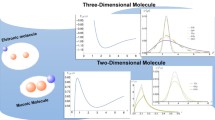Abstract
Nuclear fusion reactions of deuterium-tritium can be catalyzed by muons. When an energetic negative muon (μ) enters a deuterium-tritium mixture the following chain of reactions occurs: a) slowing down and atomic capture of μ, b) muon transfer to higher isotopes, c) μ-molecular formation d) nuclear fusion of dt. The muon is either released or captured by the nuclear fusion products (sticking). In analyzing the relevance of muon catalyzed fusion (mcf) for energy production, the problem is to maximize the number Xμ of fusion processes catalyzed by a single μ. Xμ is determined by the lifetime of μ and the frequency of the fusion events described above.
In this work it is suggested that powerful electromagnetic fields can increase the rates of the muon transfer and μ-molecular formation and thus enhance the value of Xμ.
The fusion cycle is inhibited by the slow transfer of muons between the ground states of deuterium and tritium. The fraction of muons reaching the deuterium ground state Q1S can be decreased (and thus increasing the number of muons transferred from du to the tritium ground state) by changing the route of the muon deexitation cascade under laser irradiation. The muon cascade is determined by a competition between radiative transitions, external Auger transitions, quenching of the muon levels and transfer processes. The muon transfer cross section from the 2S level of deuterium is larger by a factor of about 5 than the transfer cross section from the 2P level. Therefore the following two step process is proposed in order to enhance the rate of the muon transfer (1) : (a) a laser induced transition between the levels 2P and 2S of the deuterium (b) muon transfer by collisions to the tritium 2S level. The results show that a 0.2 eV laser (the Lamb shift in deuterium) with an intensity of about 109 W/cm2 can decrease the value of Q1S by a factor of three.
The rate of formation of the muonic molecule can also be enhanced by strong electromagnetic fields. We consider a three level system of the dtμ molecule a) a state in the continuum of tμ+d (b) the bound state of the molecule dtμ (J,V) = (1,1) and (c) the bound state (J,V) = (0,1). Under the influence of an external field a Stokes transition from the level (a) to level (b) takes place while the transition from (b) to (c) is occurring through an Auger process. It is shown that for a resonant laser frequency and intensities of 6×105 W/cm2 the Stokes efficiency (defined as the ratio between Stokes induced transitions and spontaneous decay) is about 50. However due to the stringent resonance conditions for practical lasers one uses the off resonance regime yielding an intensity of about 109 W/cm2.
Access this chapter
Tax calculation will be finalised at checkout
Purchases are for personal use only
Preview
Unable to display preview. Download preview PDF.
Similar content being viewed by others
References
See for example the following review articles: (a) S.S. Gershtein and L.I. Ponomarev, “Muon Physics,” Vol. III, V.W. Hughes and C.S. Wu, Editors, Academic Press, N.Y. (1975), p. 141
(b) L.I. Ponomarev, Proc. Sixth Int. Conf. on Atomic Physics, Plenum, N.Y. (1978), p. 182
(c) J. Rafelski, “Exotic Atoms,” K. Crowe and E. Duclos, Editors, Plenum, N.Y. (1979), p. 177
(d) L. Bracci and G. Fiorentini, Phys. Rep. 86, 169 (1982).
(e) S. Eliezer, Laser and Particle Beams 6, 63 (1988).
(a) L.I. Menshikov and L.I. Ponomarev, JETP Lett. 39, 663 (1984).
(b) L.I. Menshikov and L.I. Ponomarev, Z. Phys. D2, 1 (1986).
(a) S. Jones, Phys. Rev. Lett. 56, 588 (1986).
(b) W.H. Breunlich et al., Phys. Rev. Lett. 58, 329 (1987).
(c) K. Kabayashi, T. Ishihara and N. Toshima, Muon Cat. Fusion 2, 191 (1988).
Yu. V. Petrov and Yu. M. Shabelskii, Sov. S. Nucl. Phys. 30, 66 (1979).
(a) Yu,V. Petrov, Nature 285, 466 (1980).
(b) S. Eliezer, T. Tajima, M.N. Rosenbluth, Nuclear Fusion 27, 527 (1987).
L. Bracci & Fiorentini, Nature 297, 134 (1982).
H. Takahashi and A. Moats, Atomkerenergie 43, 188 (1983).
S. Eliezer and Z. Henis, Phys. Lett. 131A, 361 (1988).
H. Takahashi, in “Muon Catalyzed Fusion”, Ed. S. Jones, J. Rafelski, G. Hendrik, J. Monkhorst, AIP New York (1989).
S. Barnet and A.M. Lane, in “Muon Catalyzed Fusion”, Ed. S.E. Jones, J. Rafelski, G. Hendrik, J. Monkhorst, AIP New York (1989).
T. Tajiraa, S. Eliezer and R.M. Kulsrud, in “Muon Catalyzed Fusion” Ed. S.E. Jones, J. Rafelski, G. Hendrik, J. Monkhorst, AIP New York (1989).
(a) M. Leon and H.A. Bethe, Phys. Rev. 127, 637 (1962)
(b) V.E. Markushin, Sov. Phys. JETP 53, 16 (1981).
M. Leon, Phys. Lett. 35B, 413 (1971).
G. Kodoski and M. Leon, Nuovo Cimento 1B, 41 (1971).
L.I. Menshikov and L.I. Ponomarev, JETP Lett. 39, 663, (1984).
S.E. Jones et al. Phys. Rev. Lett. 56, 558 (1986).
B. Müller, S. Rafelski, M. Jandel, S.E. Jones, in “Muon Catalyzed Fusion” Ed. S.E. Jones, J. Rafelski, G. Hendrik, J. Monkhorst, AIP New York (1989).
L.I. Menshikov and L.I. Ponomarev, Z. Phys. D2, 1 (1986).
H.E. Rafelski, B. Miller, J. Rafelski, D. Trautman and R.D. Viollier preprint AZPH-TH/88-12 (1988) to appear in “Progress in Particle and Nuclear Physics”.
Author information
Authors and Affiliations
Editor information
Editors and Affiliations
Rights and permissions
Copyright information
© 1991 Springer Science+Business Media New York
About this chapter
Cite this chapter
Eliezer, S., Henis, Z. (1991). Laser Induced Transitions in Muon Catalyzed Fusion. In: Hora, H., Miley, G.H. (eds) Laser Interaction and Related Plasma Phenomena. Springer, Boston, MA. https://doi.org/10.1007/978-1-4615-3804-2_7
Download citation
DOI: https://doi.org/10.1007/978-1-4615-3804-2_7
Publisher Name: Springer, Boston, MA
Print ISBN: 978-1-4613-6696-6
Online ISBN: 978-1-4615-3804-2
eBook Packages: Springer Book Archive




